Coburn J.W. Algebra and Trigonometry
Подождите немного. Документ загружается.

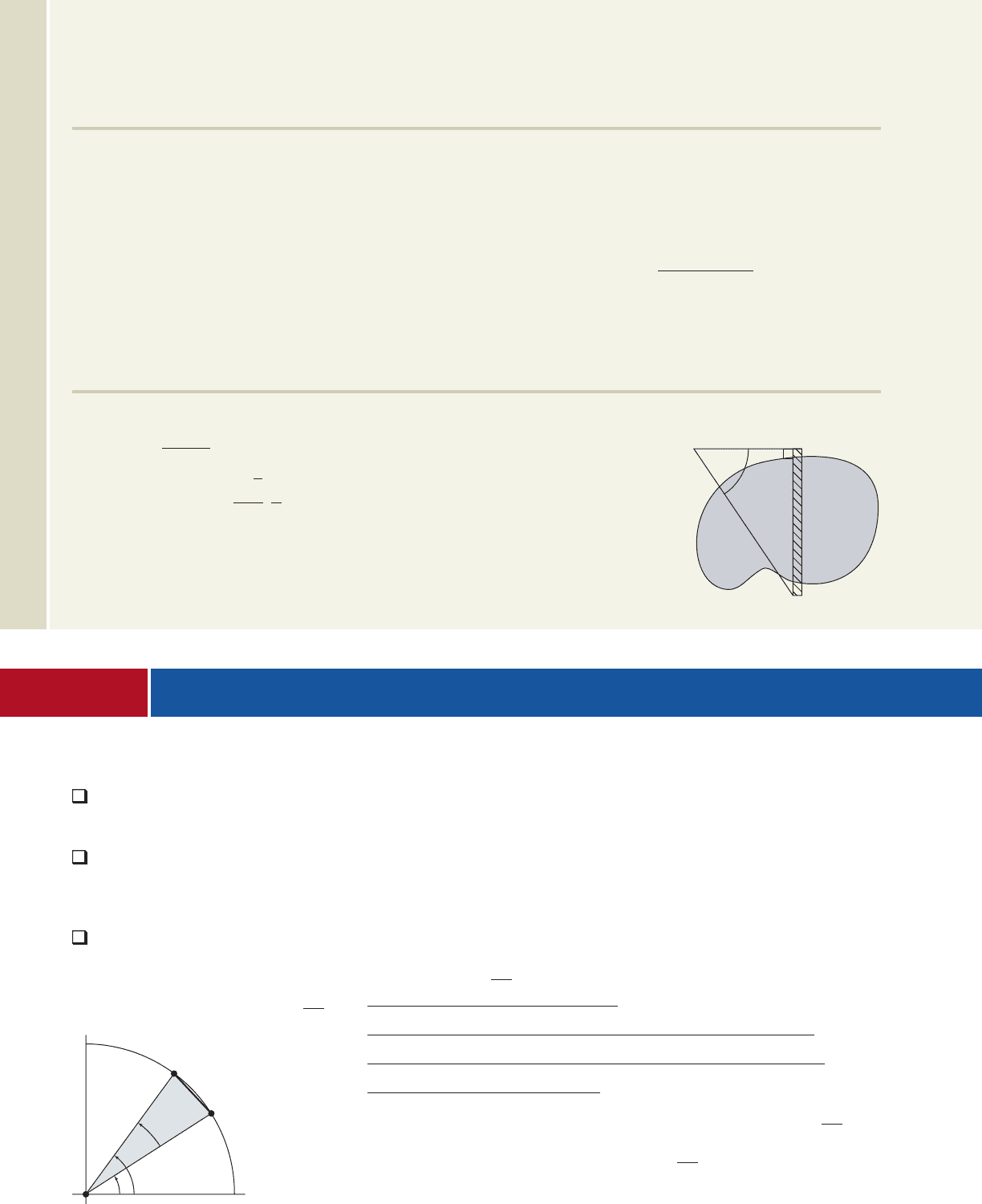
College Algebra & Trignometry—
70. (3.5) Graph the rational function given.
71. (5.2) Verify that is a point on the unit
circle, then state the values of sin t, cos t, and tan t
associated with this point.
a
27
4
,
3
4
b
h1x2
x 1
x
2
4
72. (5.7) Use an
appropriate trig ratio
to find the length of
the bridge needed to
cross the lake shown
in the figure.
73. (2.5) Graph using
transformations of a
basic function:
f 1x22
x 3
6
630 CHAPTER 6 Trigonometric Identities, Inverses, and Equations 6-16
MAINTAINING YOUR SKILLS
d
62
400 yd
EXTENDING THE CONCEPT
differences. Using the Internet or the resources of a
library, do some research on the functions sinh t, cosh
t, and tanh t, where t is any real number. In particular,
see how the Pythagorean identities compare/contrast
between the two forms of trigonometry.
68. Verify the identity
69. Use factoring to show the equation is an identity:
sin
4
x 2 sin
2
x cos
2
x cos
4
x 1.
sin
6
x cos
6
x
sin
4
x cos
4
x
1 sin
2
x cos
2
x.
67. Just as the points P(x, y) on the unit circle
are used to name the circular
trigonometric functions, the points P(x, y) on the unit
hyperbola are used to name what are
called the hyperbolic trigonometric functions. The
hyperbolic functions are used extensively in many of
the applied sciences. The identities for these
functions have many similarities to those for the
circular functions, but also have some significant
x
2
y
2
1
x
2
y
2
1
Exercise 72
6.3 The Sum and Difference Identities
Learning Objectives
In Section 6.3 you will learn how to:
A. Develop and use sum
and difference identities
for cosine
B. Use the cofunction iden-
tities to develop the sum
and difference identities
for sine and tangent
C. Use the sum and differ-
ence identities to verify
other identities
The sum and difference formulas for sine and cosine have a long and ancient history.
Originally developed to help study the motion of celestial bodies, they were used cen-
turies later to develop more complex concepts, such as the derivatives of the trig func-
tions, complex number theory, and the study wave motion in different mediums. These
identities are also used to find exact results (in radical form) for many nonstandard
angles, a result of great importance to the ancient astronomers and still of notable math-
ematical significance today.
A. The Sum and Difference Identities for Cosine
On a unit circle with center C, consider the point A on the terminal side of angle
and point B on the terminal side of angle as shown in Figure 6.1. Since the
coordinates of A and B are and respectively. Using the dis-
tance formula, we find that is equal to
With no loss of generality, we can rotate sector ACB clockwise, until side coin-
cides with the x-axis. This creates new coordinates of (1, 0) for B, and new coordinates
of for A, but the distance remains unchanged! (see
Figure 6.2). Recomputing the distance gives
AB
1cos1 2, sin1 22
CB
cos
2
u sin
2
u 1
22 2 cos cos 2 sin sin
21cos
2
sin
2
2 1cos
2
sin
2
2 2 cos cos 2 sin sin
2cos
2
2 cos cos cos
2
sin
2
2 sin sin sin
2
AB 21cos cos 2
2
1sin sin 2
2
AB
1cos , sin 2,1cos , sin 2
r 1,,
,
A
(cos , sin )
(cos , sin )
B
C
1
Figure 6.1
binomial
squares
regroup
cob19529_ch06_615-700.qxd 11/11/08 8:19 PM Page 630 epg HD 049:Desktop Folder:11/11/08:z_PDF:
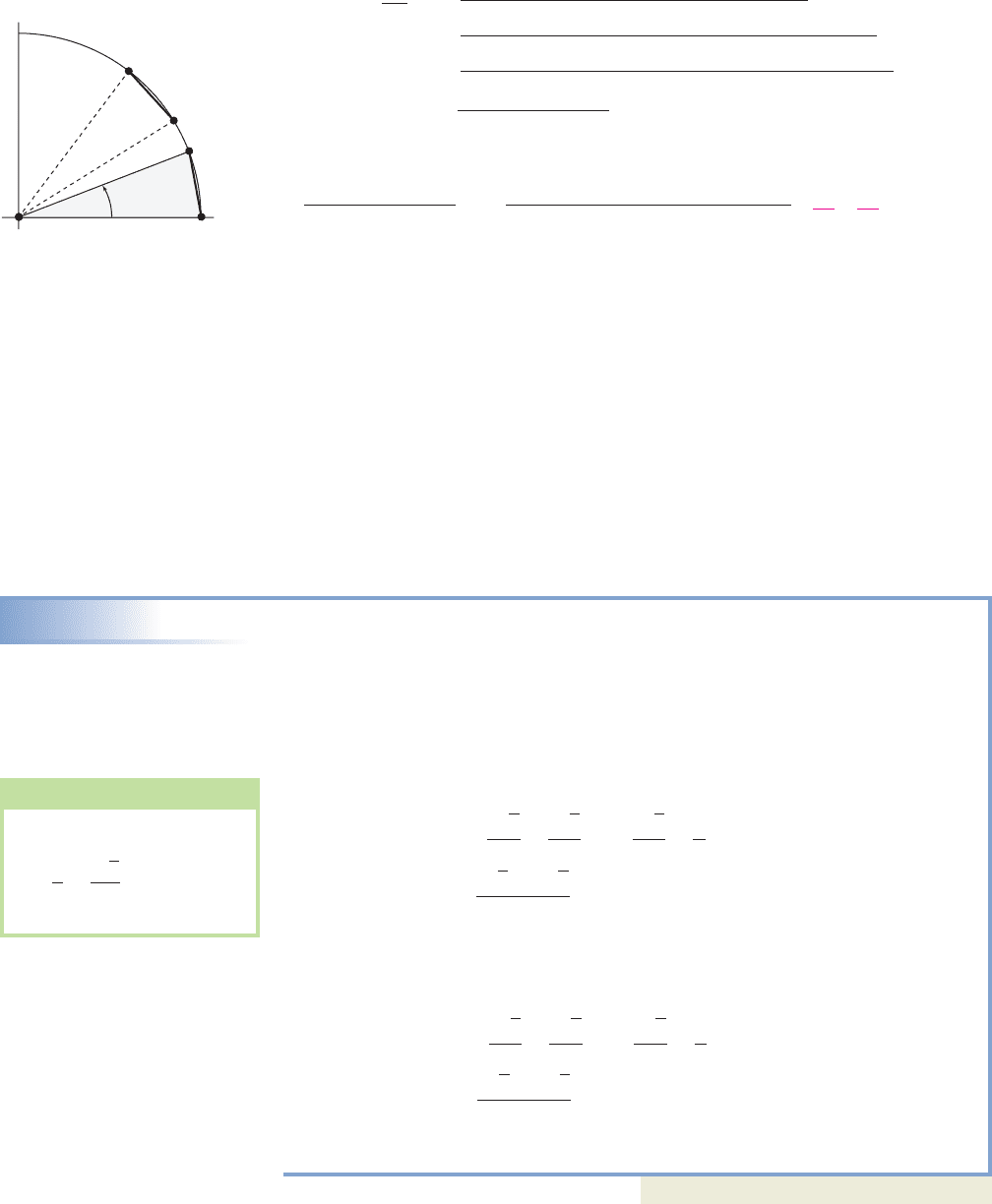
6-17 Section 6.3 The Sum and Difference Identities 631
Since both expressions represent the same distance, we can set them equal to each
other and solve for
property of radicals
subtract 2
divide both sides by
The result is called the difference identity for cosine. The sum identity for
cosine follows immediately, by substituting for .
difference identity
substitute for
The sum and difference identities can be used to find exact values for the trig func-
tions of certain angles (values written in nondecimal form using radicals), simplify
expressions, and to establish additional identities.
EXAMPLE 1
Finding Exact Values for Non-Standard Angles
Use the sum and difference identities for cosine to find exact values for
a. b.
Check results on a calculator.
Solution
Each involves a direct application of the related identity, and uses special values.
a.
difference identity
standard values
combine terms
To 10 decimal places,
b.
sum identity
standard values
combine terms
To 10 decimal places,
Now try Exercises 7 through 12
These identities are listed here using the “ ” and “ ” notation to avoid needless
repetition. In their application, use both upper symbols or both lower symbols depend-
ing on whether you’re evaluating the cosine of a sum or difference of two angles. As with
the other identities, these can be rewritten to form other members of the identity family,
as when they are used to consolidate a larger expression. This is shown in Example 2.
cos 75° 0.2588190451.
cos 75°
16
12
4
a
12
2
b a
13
2
b a
12
2
b a
1
2
b
45°, 30° cos145° 30°2 cos 45° cos 30° sin 45° sin 30°
cos1 2 cos cos sin sin
cos 15° 0.9659258263.
cos 15°
16
12
4
a
12
2
b a
13
2
b a
12
2
b a
1
2
b
45°, 30° cos145° 30°2 cos 45° cos 30° sin 45° sin 30°
cos1 2 cos cos sin sin
cos 75° cos145° 30°2cos 15° cos145° 30°2
cos 12 cos ; sin 12sin cos1 2 cos cos sin sin
cos1 342 cos cos12 sin sin12
cos1 2 cos cos sin sin
2 cos1 2 cos cos sin sin
2 cos1 22 cos cos 2 sin sin
2 2 cos1 2 2 2 cos cos 2 sin sin
AB AB 12 2 cos1 2 12 2 cos cos 2 sin sin
cos1 2.
12 2 cos1 2
23cos
2
1 2 sin
2
1 24 2 cos1 2 1
2cos
2
1 2 2 cos1 2 1 sin
2
1 2
AB 23cos1 2 14
2
3sin1 2 04
2
WORTHY OF NOTE
Be aware that
and in general
f 1a b2 f 1a2 f 1b2.
a0
1
2
13
2
b
30°2 cos 60° cos 30°
cos160°
(cos( ), sin( ))
A
B
C
(1, 0)
1
Figure 6.2
College Algebra & Trignometry—
cob19529_ch06_615-700.qxd 11/11/08 6:23 PM Page 631 epg HD 049:Desktop Folder:11/11/08:z_PDF:
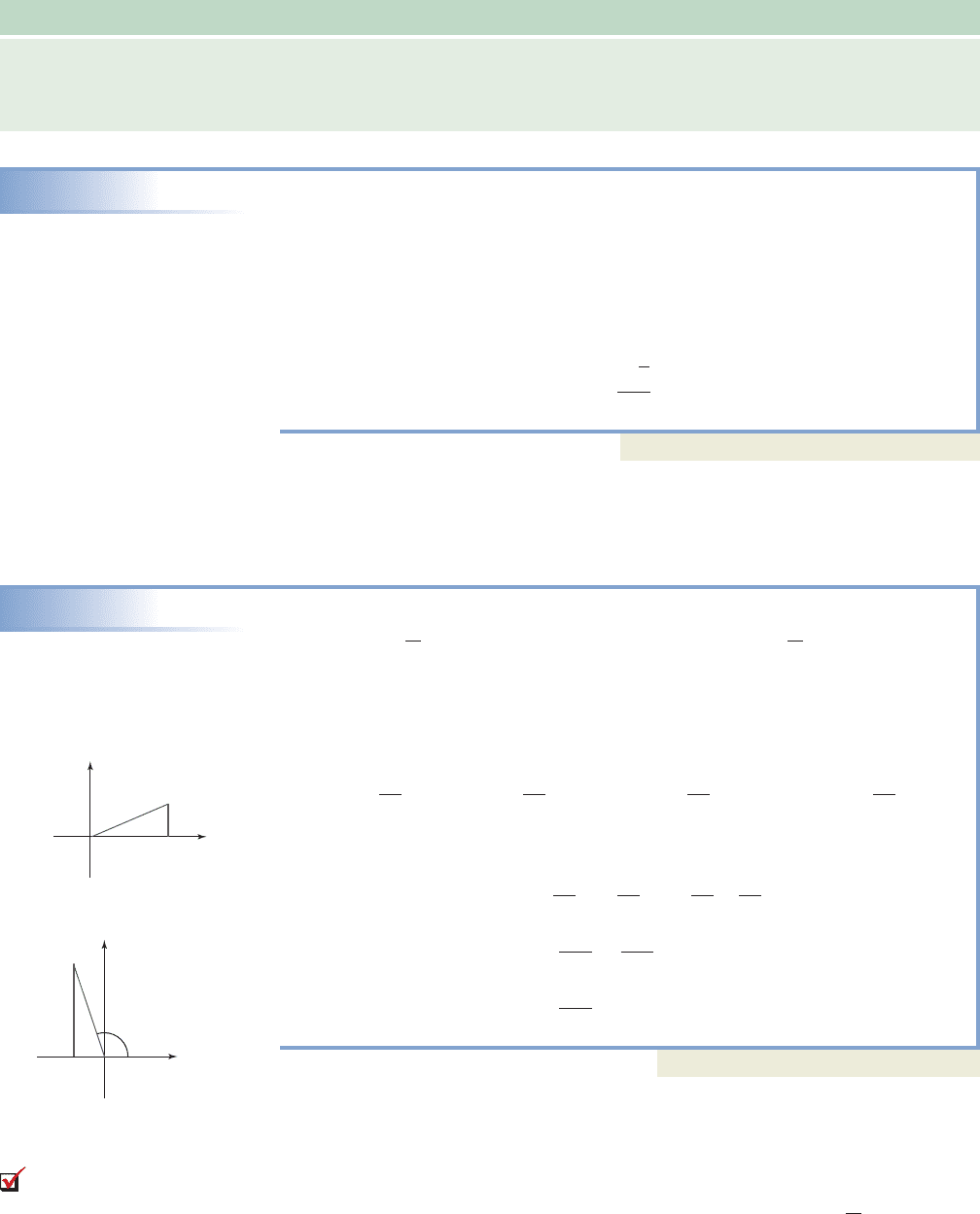
632 CHAPTER 6 Trigonometric Identities, Inverses, and Equations 6-18
The Sum and Difference Identities for Cosine
cosine family:
functions repeat, signs alternate
can be used to expand or contract
EXAMPLE 2
Using a Sum/Difference Identity to Simplify an Expression
Write as a single expression in cosine and evaluate:
Solution
Since the functions repeat and are expressed as a difference, we use the sum
identity for cosine to rewrite the difference as a single expression.
sum identity for cosine
The expression is equal to
Now try Exercises 13 through 16
The sum and difference identities can be used to evaluate the cosine of the sum of
two angles, even when they are not adjacent, or even expressed in terms of cosine.
EXAMPLE 3
Computing the Cosine of a Sum
Given with the terminal side in QI, and with the terminal
side in QII. Compute the value of
Solution
To use the sum formula we need the value of and . Using
the given information about the quadrants along with the Pythagorean theorem, we
draw the triangles shown in Figures 6.3 and 6.4, yielding the values that follow.
Using gives this result:
Now try Exercises 17 and 18
B. The Sum and Difference Identities for Sine and Tangent
The cofunction identities were actually introduced in Section 5.1, using the comple-
mentary angles in a right triangle. In this section we’ll verifythat cosa
2
b sin
204
325
84
325
120
325
cos1 2 a
12
13
ba
7
25
b a
5
13
ba
24
25
b
cos1 2 cos cos sin sin
cos
12
13
1QI2, sin
5
13
1QI2, cos
7
25
1QII2, and sin
24
25
1QII2
sin cos , sin , cos ,
cos1 2.
tan
24
7
sin
5
13
cos 135°
12
2
.
57°, 78° c os 57° cos 78° sin 57° sin 78° cos157° 78°2
c os cos sin sin cos1 2
cos 57° cos 78° sin 57° sin 78°
cos cos sin sin cos1 2
cos1 2 cos cos sin sin
A. You’ve just learned how
to develop and use sum and
difference identities for cosine
12
5
2
12
2
13
2
13
5
x
y
27
25
24
x
y
(27)
2
⫹ 24
2
⫽ 25
2
Figure 6.3
Figure 6.4
College Algebra & Trignometry—
cob19529_ch06_631-639.qxd 01/13/2009 07:49 PM Page 632 ssen 1 HD 049:Desktop Folder:Satya 13/01/09:Used file:MHDQ092-6.3:

6-19 Section 6.3 The Sum and Difference Identities 633
and For the first, we use the difference identity for cosine to
obtain
For the second, we use and replace with the real number .
This gives
cofunction identity for cosine
replace with
result, note
This establishes the cofunction relationship for sine: for any
real number t. Both identities can be written in terms of the real number t. See
Exercises 19 through 24.
The Cofunction Identities
The sum and difference identities for sine can easily be developed using cofunction
identities. Since we need only rename t as the sum or
the difference and work from there.
cofunction identity
substitute for t
regroup argument
apply difference identity
for cosine
result
The difference identity for sine is likewise developed. The sum and difference
identities for tangent can be derived using ratio identities and their derivation is left as
an exercise (see Exercise 78).
sin1 2 sin cos cos sin
cosa
2
bcos sina
2
bsin
cosca
2
b d
1 2 sin1 2 cosc
2
1 2d
sin t cosa
2
tb
1 2
1 2sin t cosa
2
tb,
sina
2
tb cos tcosa
2
tb sin t
sina
2
tb cos t
c
2
a
2
tbd t cos t sina
2
tb
2
t
cosa
2
c
2
tdb sina
2
tb
cosa
2
b sin
2
tcosa
2
b sin ,
sin
102cos 112sin
cosa
2
b cos
2
cos sin
2
sin
sina
2
b cos .
WORTHY OF NOTE
It is worth pointing out that in
Example 3, if we approximate
the values of and using
tables or a calculator, we find
and .
Sure enough,
cos122.62° 106.26°2
204
325
!
106.26°
22.62°
College Algebra & Trignometry—
cob19529_ch06_631-639.qxd 12/26/08 20:12 Page 633

634 CHAPTER 6 Trigonometric Identities, Inverses, and Equations 6-20
The Sum and Difference Identities for Sine and Tangent
sine family:
tangent family:
EXAMPLE 4A
Simplifying Expressions Using Sum/Difference Identities
Write as a single expression in sine:
Solution
Since the functions in each term alternate and the expression is written as a sum,
we use the sum identity for sine:
sum identity for sine
substitute 2t for and t for
The expression is equal to sin(3t).
EXAMPLE 4B
Simplifying Expressions Using Sum/Difference Identities
Use the sum or difference identity for tangent to find the exact value of
Solution
Since an exact value is requested, must be the sum or difference of two
standard angles. A casual inspection reveals . This gives
sum identity for tangent
simplify expression
Now try Exercises 25 through 54
C. Verifying Other Identities
Once the sum and difference identities are established, we can simply add these to the
tools we use to verify other identities.
1 13
1 13
tana
2
3
b13, tana
4
b 1
13 1
1 1132112
2
3
,
4
tana
2
3
4
b
tana
2
3
b tana
4
b
1 tana
2
3
b tana
4
b
tan1 2
tan tan
1 tan tan
11
12
2
3
4
11
12
tan
11
12
.
sin12t2cos t cos12t2sin t sin12t t2
sin cos cos sin sin 1 2
sin12t2 cos t cos12t2 sin t.
tan tan
1 tan tan
tan1 2
tan1 2
tan tan
1 tan tan
sin cos cos sin sin1 2
sin1 2sin cos cos sin
functions alternate, signs repeat
can be used to expand or contract
signs match original in numerator
signs alternate in denominator
can be used to expand or contract
B. You’ve just learned how
to use the cofunction identi-
ties to develop the sum and
difference identities for sine
and tangent
College Algebra & Trignometry—
cob19529_ch06_631-639.qxd 12/29/2008 08:50 am Page 634

6-21 Section 6.3 The Sum and Difference Identities 635
EXAMPLE 5
Verifying an Identity
Verify that is an identity.
Solution
Using a direct application of the difference formula for tangent we obtain
Now try Exercises 55 through 60
EXAMPLE 6
Verifying an Identity
Verify that is an identity.
Solution
Using the sum and difference formulas for sine we obtain
Now try Exercises 61 through 68
sin
2
sin
2
sin
2
sin
2
sin
2
sin
2
sin
2
sin
2
sin
2
11 sin
2
2 11 sin
2
2 sin
2
sin
2
cos
2
cos
2
sin
2
sin1 2sin1 2 1sin cos cos sin 21sin cos cos sin 2
sin1 2sin1 2 sin
2
sin
2
tan a
4
b 1
tan 1
1 tan
tan 1
tan 1
,
4
tana
4
b
tan tan
4
1 tan tan
4
tana
4
b
tan 1
tan 1
C. You’ve just learned how
to use the sum and difference
identities to verify other
identities
use to write the
expression solely in terms of sine
distribute
simplify
cos
2
x 1 sin
2
x
1AB21A B2 A
2
B
2
6.3 EXERCISES
CONCEPTS AND VOCABULARY
Fill in each blank with the appropriate word or phrase.
Carefully reread the section if needed.
1. Since we know
is since in .
2. To find an exact value for , use the sum
identity for tangent with a and b .
3. For the cosine sum/difference identities, the
functions in each term, with the
sign between them.
4. For the sine sum/difference identities, the functions
in each term, with the sign
between them.
tan 105°
tan 6 0tan 60° tan 105°
tan 45° tan 45° tan 60° 7 1,
5. Discuss/Explain how we know the exact value for
will be negative, prior
to applying any identity.
6. Discuss/Explain why
is an identity, even though the arguments of
cosine have been reversed. Then verify the
identity.
tan1 2
sin1 2
cos1 2
cos
11
12
cosa
2
3
4
b
College Algebra & Trignometry—
cob19529_ch06_631-639.qxd 12/26/08 20:18 Page 635

636 CHAPTER 6 Trigonometric Identities, Inverses, and Equations 6-22
DEVELOPING YOUR SKILLS
27.
28.
Find the exact value of the given expressions.
29.
30.
31.
32.
33. For with terminal side in QII and
with terminal side in QIII, find
a. b.
34. For with terminal side in QI and
with terminal side in QII, find
a. b.
Find the exact value of the expression given using a sum
or difference identity. Some simplifications may involve
using symmetry and the formulas for negatives.
35. 36.
37. 38.
39. 40.
41. 42. tana
12
btana
2
3
b
tan 75°tan 150°
sina
11
12
bsina
5
12
b
sin175°2sin 105°
tan1 2sin1 2
cos
12
37
csc
29
20
tan1 2sin1 2
cot
15
8
cos
7
25
tana
3
20
b tana
10
b
1 tana
3
20
b tana
10
b
tana
11
21
b tana
4
21
b
1 tana
11
21
b tana
4
21
b
sina
11
24
b cosa
5
24
b cosa
11
24
b sina
5
24
b
sin 137° cos 47° cos 137° sin 47°
tana
x
2
b tana
x
8
b
1 tana
x
2
b tana
x
8
b
tan152 tan122
1 tan152 tan122
Find the exact value of the expression given using a
sum or difference identity. Some simplifications may
involve using symmetry and the formulas for
negatives.
7. 8.
9. 10.
Use sum/difference identities to verify that both
expressions give the same result.
11. a. b.
12. a. b.
Rewrite as a single expression in cosine.
13.
14.
Find the exact value of the given expressions.
15.
16.
17. For with terminal side in QIV and
with terminal side in QII, find
18. For with terminal side in QII and
with terminal side in QII, find
Use a cofunction identity to write an equivalent
expression.
19. 20. 21.
22. 23. 24.
Rewrite as a single expression.
25.
26. sina
x
2
b cosa
x
3
b cosa
x
2
b sina
x
3
b
sin13x2 cos15x2 cos13x2 sin15x2
cosa
3
bsina
6
bseca
10
b
tana
5
12
bsin 18°cos 57°
cos1 2.
sec
89
39
sin
112
113
cos1 2.
tan
5
12
sin
4
5
cosa
7
36
b cosa
5
36
b sina
7
36
b sina
5
36
b
cos 183° cos 153° sin 183° sin 153°
cosa
3
b cosa
6
b sina
3
b sina
6
b
cos172 cos122 sin172 sin122
cosa
4
3
b
cosa
6
4
b
cos1120° 45°2cos145° 30°2
cosa
5
12
bcosa
7
12
b
cos 135°cos 105°
College Algebra & Trignometry—
cob19529_ch06_615-700.qxd 11/11/08 6:23 PM Page 636 epg HD 049:Desktop Folder:11/11/08:z_PDF:
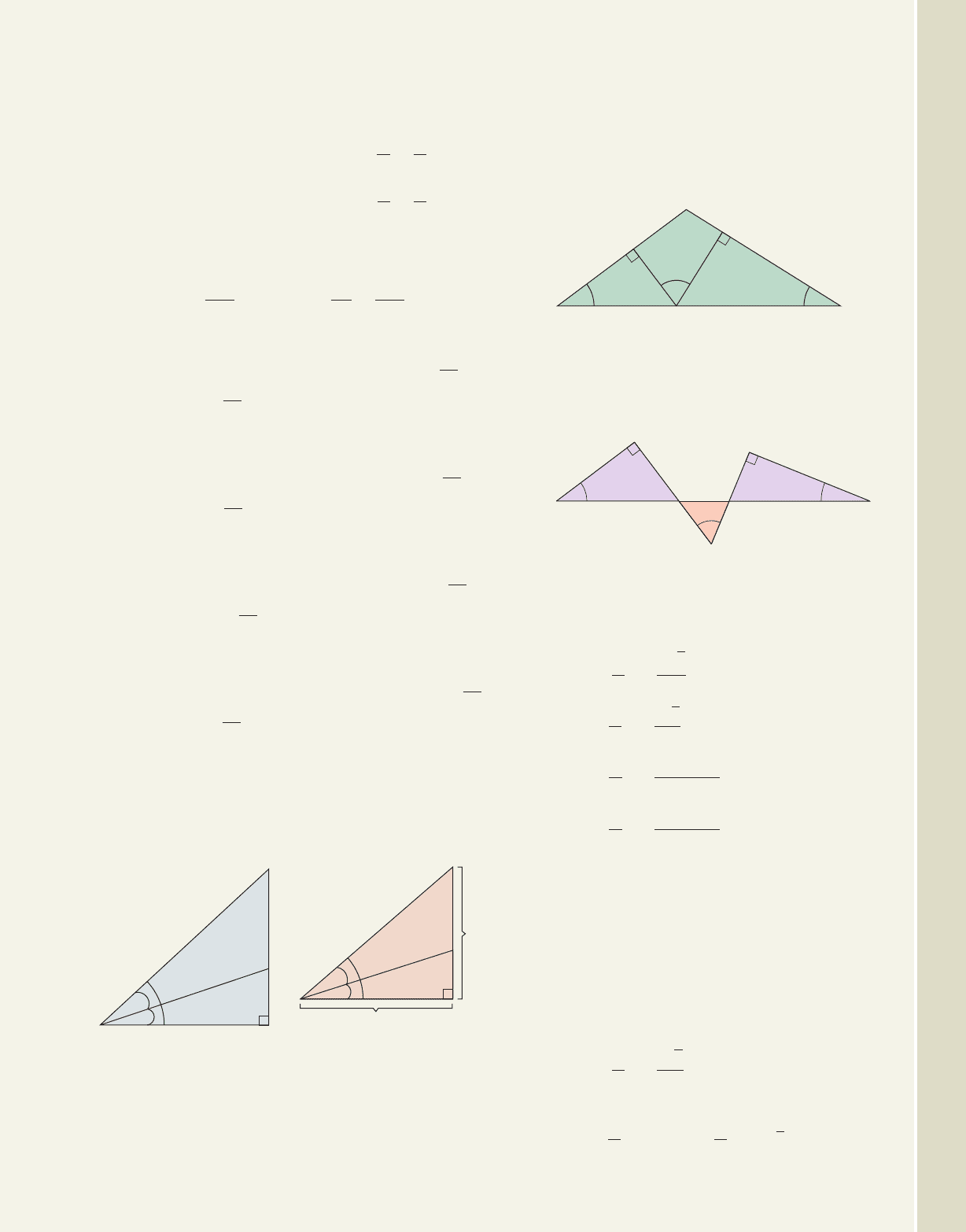
6-23 Section 6.3 The Sum and Difference Identities 637
Use sum/difference identities to verify that both
expressions give the same result.
43. a. 44. a.
b. b.
45. Find given . See
Exercises 7 and 35.
46. Find given See
Exercises 10 and 37.
47. Gi
ven and are acute angles with
and find
a. b. c.
48. Given and are acute angles with
and find
a. b. c.
49. Given and are obtuse angles with
and find
a. b. c.
50. Given and are obtuse angles with
and find
a. b. c.
51. Use the diagram indicated to compute the following:
a. sin A b. cos A c. tan A
tan1 2cos1 2sin1 2
sin
35
37
,
tan
60
11
tan1 2cos1 2sin1 2
cos
13
85
,
sin
28
53
tan1 2cos1 2sin1 2
sec
25
7
,
cos
8
17
tan1 2cos1 2sin1 2
tan
35
12
,
sin
12
13
2
5
12
19
12
.cosa
19
12
b
150° 105° 255°sin 255°
sina
4
6
bsin1135° 120°2
sina
3
4
bsin145°30°2
53. For the figure indicated, show that and
compute the following:
a. b. c.
54. For the figure indicated, show that and
compute the following:
a. b. c.
Verify each identity.
55.
56.
57.
58.
59.
60.
61.
62.
63.
64.
65.
66.
67. Use a difference identity to show
68. Use sum/difference identities to show
sinax
4
b sinax
4
b 12 sin x.
cosax
4
b
12
2
1cos x sin x2.
cos13t2 4 cos
3
t 3 cos t
sin13t24 sin
3
t 3 sin t
sin12t2 2 sin t cos t
cos12t2 cos
2
t sin
2
t
sin1 2 sin1 2 2 sin sin
cos1 2 cos1 2 2 cos cos
tanax
4
b
tan x 1
tan x 1
tanax
4
b
1 tan x
1 tan x
sinax
4
b
12
2
1sin x cos x2
cosax
4
b
22
2
1cos x sin x2
cos1 2cos
sin1 2 sin
tan cos sin
tan cos sin
12
5
30
A
15
8
15
45

Exercise 51
Exercise 52
52. Use the diagram indicated to compute the
following:
a. b. c. tan cos sin
32
24
28
45
␣

␣
6
8
12
5
College Algebra & Trignometry—
Exercise 53
Exer
cise 54
cob19529_ch06_631-639.qxd 12/29/08 19:33 Page 637

69. Force and equilibrium:
The force and equilibrium when a screw jack is
used can be modeled by the formula shown, where
p is the pitch angle of the screw, W is the weight of
the load, is the angle of friction, with k and c
being constants related to a particular jack.
Simplify the formula using the difference formula
for tangent given and
4
.p
6
F
Wk
c
tan1p 2
70. Brewster’s law:
Brewster’s law of optics states that when
unpolarized light strikes a dielectric surface, the
transmitted light rays and the reflected light rays
are perpendicular to each other. The proof of
Brewster’s law involves the expression
. Use the
difference identity for sine to verify that this
expression leads to Brewster’s law.
n
1
sin
p
n
2
sina
2
p
b
tan
p
n
2
n
1
638 CHAPTER 6 Trigonometric Identities, Inverses, and Equations 6-24
WORKING WITH FORMULAS
APPLICATIONS
71. AC circuits: In a study of AC circuits, the equation
sometimes arises. Use a sum
identity and algebra to show this equation is
equivalent to
72. Fluid mechanics: In studies of fluid mechanics,
the equation
sometimes arises. Use a difference identity to show
that if the equation is equivalent to
.
73. Art and mathematics: When working in two-
point geometric perspective, artists must scale their
work to fit on the paper or canvas they are using. In
doing so, the equation arises.
Rewrite the expression on the right in terms of sine
and cosine, then use the difference identities to
show the equation can be rewritten as .
74. Traveling waves: If two waves of the same
frequency, velocity, and amplitude are traveling
along a string in opposite directions, they can be
represented by the equations
and . Use the sum and
difference formulas for sine to show the result
of these waves can be expressed as
Y
R
2A sin1kx2cos1t2.
Y
R
Y
1
Y
2
Y
2
A sin1kx t2
Y
1
A sin1kx t2
A
B
tan
2
A
B
tan
tan190° 2
cos cot sin 1
1
V
1
2
V
2
,
1
V
1
sin
2
V
2
sin1 2
R
1
C1tan s tan t2
.
R
cos s cos t
C sin1s t2
75. Pressure on the eardrum: If a frequency generator
is placed a certain distance from the ear, the pressure
on the eardrum can be modeled by the function
where f is the frequency and t is
the time in seconds. If a second frequency generator
with identical settings is placed slightly closer to
the ear, its pressure on the eardrum could be
represented by , where
C is a constant. Show that if , the total
pressure on the eardrum is
.
76. Angle between two cables: Two cables used to
steady a radio tower are attached to the tower at
heights of 5 ft and 35 ft, with both secured to a
stake 12 ft from the tower (see figure). Find the
value of , where is the angle between the
upper and lower cables.
cos
P1t2 A3sin12ft2 cos12ft24
3P
1
1t2 P
2
1t24
C
2
P
2
1t2 A sin12ft C2
P
1
1t2 A sin12ft2,
12 ft
35 f
t
5 ft
College Algebra & Trignometry—
Exercise 76
cob19529_ch06_631-639.qxd 01/13/2009 07:50 PM Page 638 ssen 1 HD 049:Desktop Folder:Satya 13/01/09:Used file:MHDQ092-6.3:
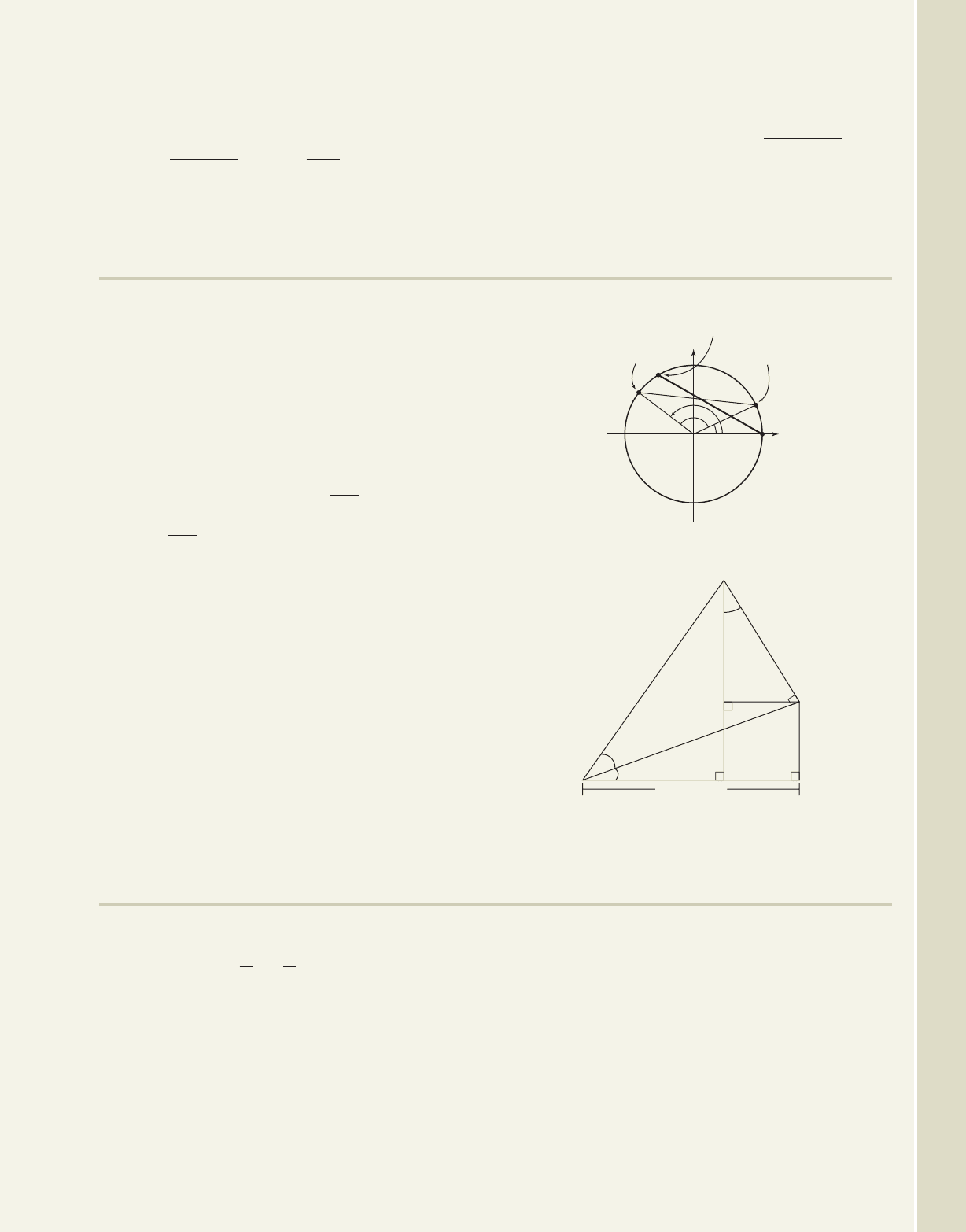
77. Difference quotient: Given show that
the difference quotient results in the expression
sin x
cos h 1
h
cos xa
sin h
h
b.
f1x2 sin x,
78. Difference identity: Derive the difference identity
for tangent using
(Hint: After applying the difference identities,
divide the numerator and denominator by
.)
cos cos
tan1 2
sin1 2
cos1 2
.
6-25 Section 6.3 The Sum and Difference Identities 639
EXTENDING THE CONCEPT
A family of identities called the angle reduction
formulas, will be of use in our study of complex
numbers and other areas. These formulas use the period
of a function to reduce large angles to an angle in
[0, ) or [0, ) having an equivalent function value:
(1) ; (2) . Use
the reduction formulas to find values for the following
functions (note the formulas can also be expressed in
degrees).
79. 80.
81. 82.
83. An alternative method of proving the difference
formula for cosine uses a unit circle and the fact
that equal arcs are subtended by equal chords
( in the diagram). Using a combination of
algebra, the distance formula, and a Pythagorean
identity, show that
(start by computing D
2
and d
2
). Then
discuss/explain how the sum identity can be found
using the fact that
84. A proof without words:Verify the Pythagorean
theorem for each right triangle in the diagram, then
discuss/explain how the diagram offers a proof of
the sum identities for sine and cosine. Be detailed
and thorough.
12.
sin sin
cos1 2 cos cos
D d
sin 2385°sina
41
6
b
cosa
91
6
bcos 1665°
sin1t 2k2 sin tcos1t 2k2 cos t
2360°
D
d
(cos , sin ) (cos , sin )
(1, 0)
(cos( ), sin( ))
sin B cos A
sin B sin A
sin B
A
B
A
cos B
cos B cos A
cos B sin A
1
Exercise 83
Exercise 84
MAINTAINING YOUR SKILLS
85. (5.3/5.4) State the period of the functions given:
a.
b.
86.
(2.7) Graph the piecewise-defined function given:
f 1x2 •
3 x 6 1
x
2
1 x 1
xx7 1
y 4 tana2x
4
b
y 3 sina
8
x
3
b
87. (5.2) Clarence the Clown is about to be shot from a
circus cannon to a safety net on the other side of
the main tent. If the cannon is 30 ft long and must
be aimed at for Clarence to hit the net, the
end of the cannon must be how high from ground
level?
88. (2.3) Find the equation of the line parallel to
, containing the point (5, ).
Write your answer in standard form.
22x 5y 10
40°
College Algebra & Trignometry—
cob19529_ch06_631-639.qxd 01/14/2009 12:29 am Page 639 ssen 1 HD 049:Don't Delete:Satya don't del:Satya 13/01/09:Used file:MHDQ092-6.3:
